Bad Dürrenberg | |
|---|---|
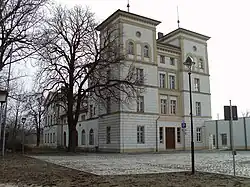 Train station | |
 Coat of arms | |
Location of Bad Dürrenberg within Saalekreis district 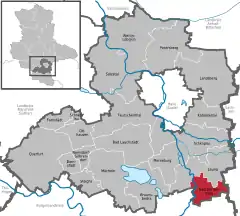 | |
 Bad Dürrenberg  Bad Dürrenberg | |
| Coordinates: 51°17′N 12°4′E / 51.283°N 12.067°E | |
| Country | Germany |
| State | Saxony-Anhalt |
| District | Saalekreis |
| Government | |
| • Mayor (2022–29) | Christoph Schulze[1] (CDU) |
| Area | |
| • Total | 36.13 km2 (13.95 sq mi) |
| Elevation | 104 m (341 ft) |
| Population (2021-12-31)[2] | |
| • Total | 11,389 |
| • Density | 320/km2 (820/sq mi) |
| Time zone | UTC+01:00 (CET) |
| • Summer (DST) | UTC+02:00 (CEST) |
| Postal codes | 06231 |
| Dialling codes | 03462 |
| Vehicle registration | SK |
| Website | www.stadt-bad-duerrenberg.de |
Bad Dürrenberg is a spa town in the Saalekreis district, in Saxony-Anhalt, Germany. It is situated on the river Saale, approx. 8 km southeast of Merseburg. It is known for its graduation tower, the largest one in Germany.
Geography
The town of Bad Dürrenberg is located on the river Saale between the cities of Leipzig, Merseburg and Weißenfels. In the south of the town, the Ellerbach flows into the right side of the Saale.
Neighboring districts
The neighboring districts are Leuna to the north, Markranstädt in (Leipzig district) to the east, Lützen (Burgenlandkreis) to the south and, to the west, Weißenfels (Burgenlandkreis).
Town and hinterland
The following table shows the population of the town itself and those of the municipal divisions (Ortschaften) which were formerly independent municipalities.[3] Oebles-Schlechtewitz was absorbed into Bad Dürrenberg in 2008,[4] and Nempitz and Tollwitz in 2010.[5]
| Town | Population | Areas | 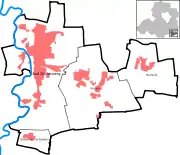 |
|---|---|---|---|
| Bad Dürrenberg | 10,805 | Bad Dürrenberg, Balditz, Goddula, Keuschberg, Kirchfährendorf, Lennewitz, Ostrau and Vesta | |
| Nempitz | 293 | Nempitz | |
| Oebles-Schlechtewitz | 209 | Oebles-Schlechtewitz | |
| Tollwitz | 1,175 | Ellerbach, Kauern, Ragwitz, Teuditz, Tollwitz and Zöllschen |
Events and festivals
Each year on the last weekend of June the town has a festival held over a period of three days, which is known as Brunnenfest (Well Celebration).
Population development
Historical population (as of 31 December unless otherwise noted). Values since 2010 also include neighboring villages which were annexed by the town.
| Year | Inhabitants |
|---|---|
| 1990 | 13,0081 |
| 1995 | 12,214 |
| 2000 | 11,902 |
| 2005 | 11,391 |
| 2006 | 11,287 |
| 2012 | 11,844 |
| 2015 | 11,763 |
| 30 June 2016 | 11,931 |
1 3 October
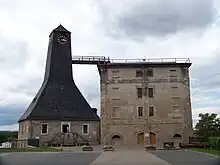
Mayors
- Kurt Eckart (SPD), May–June 1945
- Karl Herfurth (KPD), July 1945 – 1946
- Paul Drese (SED), 1946-1947
- Fritz Singer, 1948-1952
- Kurt Boose, from 1951 (deputy)
- Gerry Chisel (SED), from 1952 acting / Edmund Jatz
- Martha Wessler (SED), 1953-1976
- Liselotte Wehowski (SED), 1976-1986
- Frank Klappach (SED), 1986-1988
- Karin Zeisler (SED), 1988-1990
- Thomas Heilmann (CDU), 1990-2001
- Jürgen Elste (FDP), 2001-2008
- Árpád Nemes (CDU), 2008-2015
- Christoph Schulze (CDU), since 2015
Personality
Sons and daughters of the town

- Ibrahim Böhme (1944–1999), politician
- Lars-Broder Keil (born 1963), journalist and author
- Andreas Ihle (born 1979), world champion and Olympic champion in canoe racing
Those associated with the town
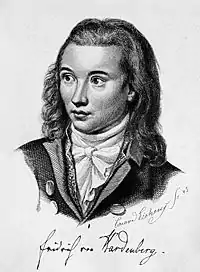
- Novalis (1772–1801), early Romantics, philosopher and lawyer
- Johann Trommsdorff (1770–1837), pharmacist and chemist
- Karl von Fritsch (1838–1906), a paleontologist and geologist, president of the Leopoldina
- Ernst Fraenkel (political scientist) (1898–1975), political scientist and lawyer
- Karin Haftenberger, (born 1948), canoeist, competed in the 1968 Summer Olympics
Twin towns – sister cities
 Melle, Germany
Melle, Germany Caudebec-lès-Elbeuf, France
Caudebec-lès-Elbeuf, France Ciechocinek, Poland
Ciechocinek, Poland Encs, Hungary
Encs, Hungary
Gallery

 Spa gardens
Spa gardens
- Churches


References
- ↑ Bürgermeisterwahlen in den Gemeinden, Endgültige Ergebnisse, Statistisches Landesamt Sachsen-Anhalt, accessed 10 November 2022.
- ↑ "Bevölkerung der Gemeinden – Stand: 31. Dezember 2021" (PDF) (in German). Statistisches Landesamt Sachsen-Anhalt. June 2022.
- ↑ Hauptsatzung, Stadt Bad Dürrenberg, October 2019.
- ↑ Gebietsänderungen vom 01.01. bis 31.12.2008, Statistisches Bundesamt
- ↑ Gebietsänderungen vom 01. Januar bis 31. Dezember 2010, Statistisches Bundesamt